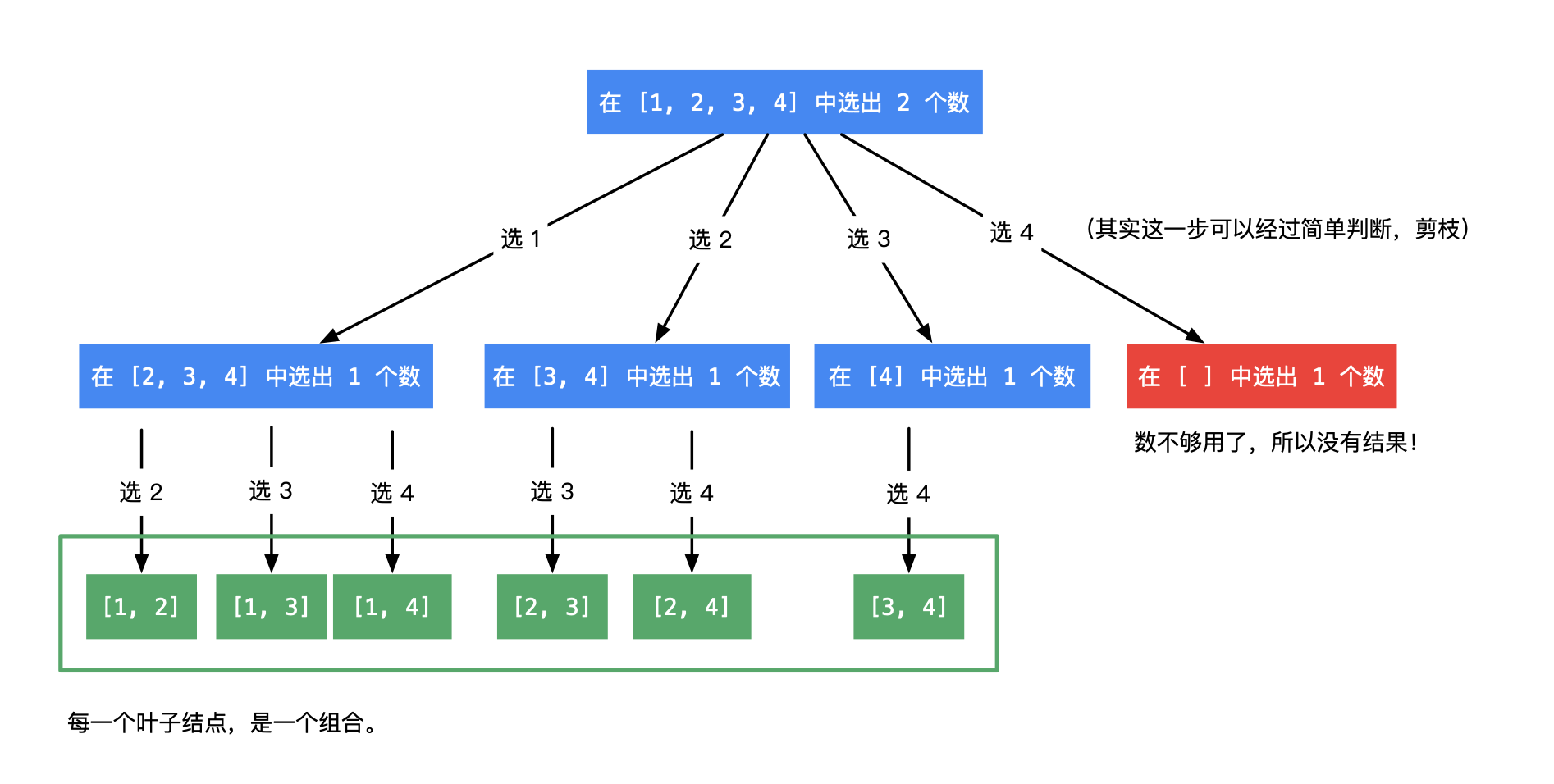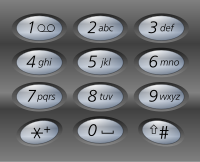组合 问题叙述 给定两个整数 n 和 k,返回范围 [1, n] 中所有可能的 k 个数的组合。
示例 1 输入:n = 4, k = 2
示例 2 输入:n = 1, k = 1
提示 1 <= n <= 20
分析 图源:力扣liweiwei1419 优质题解
Code 1 2 3 4 5 6 7 8 9 10 11 12 13 14 15 16 17 18 19 20 21 22 JAVA class Solution { List<List<Integer >> res = new ArrayList<>(); LinkedList<Integer > path = new LinkedList<>(); public List<List<Integer >> combine(int n, int k) { backTracking(n, k, 1 ); return res; } void backTracking(int n, int k, int startIndex) { if (path .size() == k) { res.add (new ArrayList<>(path )); return ; } for (int i = startIndex; i <= n - (k - path .size()) + 1 ; i++) { path .offer(i); backTracking(n, k, i + 1 ); path .removeLast(); } } }
组合总和III 来源:力扣(Leetcode)https://leetcode-cn.com/problems/combination-sum-iii/
问题叙述 找出所有相加之和为 n 的 k 个数的组合,且满足下列条件:
示例 1 输入: k = 3, n = 7
示例 2 输入: k = 3, n = 9
示例 3 输入: k = 4, n = 1
提示 2 <= k <= 9
分析 每个数字只能用一次 跟上题一样 递归时startIndex的参数值设为i+1
Code 1 2 3 4 5 6 7 8 9 10 11 12 13 14 15 16 17 18 19 20 21 22 23 JAVA class Solution { List<List<Integer>> res = new ArrayList<>() ; LinkedList<Integer> path = new LinkedList<>() ; public List<List<Integer>> combinationSum3(int k , int n ) { backTracking(k , n , 1) ; return res; } void backTracking(int k , int n , int startIndex ) { if (n < 0 ) return; if (path.size() == k && n == 0 ) { res.add(new ArrayList<>(path)); return; } for (int i = startIndex; i <= 9 ; i++) { path.offer(i); backTracking(k , n - i , i + 1) ; path.removeLast() ; } } }
电话号码的字母组合 来源:力扣(Leetcode)https://leetcode-cn.com/problems/letter-combinations-of-a-phone-number/
问题叙述 给定一个仅包含数字 2-9 的字符串,返回所有它能表示的字母组合。答案可以按 任意顺序 返回。
示例 1 输入:digits = “23”
示例 2 输入:digits = “”
示例 3 输入:digits = “2”
提示 0 <= digits.length <= 4
分析 创建一个长度为10的字符串数组 用来存储’0’ - ‘9’ 按键的对应字母值
Code 1 2 3 4 5 6 7 8 9 10 11 12 13 14 15 16 17 18 19 20 21 22 23 24 25 JAVA class Solution { List<String> res = new ArrayList<>() ; StringBuffer path = new StringBuffer() ; public List<String> letterCombinations(String digits ) { if (digits.length() ==0 ) return res; String[] nums = {"" , "" , "abc" , "def" , "ghi" , "jkl" , "mno" , "pqrs" , "tuv" , "wxyz" }; backTracking(digits , nums , 0) ; return res; } void backTracking(String digits , String[] nums , int num ) { if (num==digits.length() ){ res.add(path.to String() ); return; } String str = nums[digits .charAt (num )-'0 '] ; for (int i = 0 ; i < str.length() ; i++) { path.append(str.char At(i ) ); backTracking(digits ,nums ,num +1) ; path.deleteCharAt(path .length () -1 ); } } }
组合总和 来源:力扣(Leetcode)https://leetcode-cn.com/problems/combination-sum/
问题叙述 给你一个 无重复元素 的整数数组 candidates 和一个目标整数 target ,找出 candidates 中可以使数字和为目标数 target 的 所有 不同组合 ,并以列表形式返回。你可以按 任意顺序 返回这些组合。
示例 1 输入:candidates = [2,3,6,7], target = 7
示例 2 输入: candidates = [2,3,5], target = 8
示例 3 输入: candidates = [2], target = 1
提示 1 <= candidates.length <= 30
分析 还是做减法 画出树状图
Code 1 2 3 4 5 6 7 8 9 10 11 12 13 14 15 16 17 18 19 20 21 22 23 JAVA class Solution { List<List<Integer>> res = new ArrayList<>() ; LinkedList<Integer> path = new LinkedList<>() ; public List<List<Integer>> combinationSum(int [] candidates , int target ) { backTracking(candidates , target ,0) ; return res; } void backTracking(int [] candidates , int target ,int startIndex ) { if (target == 0 ) { res.add(new ArrayList<>(path)); return; } if (target < 0 ) return; for (int i = startIndex; i < candidates.length; i++) { path.offer(candidates[i ] ); backTracking(candidates , target - candidates [i ],i ) ; path.removeLast() ; } } }
组合总和II 来源:力扣(Leetcode)https://leetcode-cn.com/problems/combination-sum-ii/
问题叙述 给定一个候选人编号的集合 candidates 和一个目标数 target ,找出 candidates 中所有可以使数字和为 target 的组合。
示例 1 输入: candidates = [10,1,2,7,6,1,5], target = 8,
示例 2 输入: candidates = [2,5,2,1,2], target = 5,
提示 1 <= candidates.length <= 100
分析 由于待选数组有重复值
Code 1 2 3 4 5 6 7 8 9 10 11 12 13 14 15 16 17 18 19 20 21 22 23 24 25 26 27 28 29 30 31 32 33 34 35 36 37 38 39 40 41 42 43 44 45 46 47 48 49 50 51 52 53 JAVA class Solution { List<List<Integer>> res = new ArrayList<>() ; LinkedList<Integer> path = new LinkedList<>() ; public List<List<Integer>> combinationSum2(int [] candidates , int target ) { Arrays . backTracking(candidates , target , 0) ; return res; } void backTracking(int [] candidates , int target , int startIndex ) { if (target == 0 ) { res.add(new ArrayList<>(path)); return; } if (target < 0 ) return; for (int i = startIndex; i < candidates.length; i++) { if (i > startIndex && candidates[i ] == candidates[i - 1 ] ) continue; path.offer(candidates[i ] ); backTracking(candidates , target - candidates [i ], i +1) ; path.removeLast() ; } } } class Solution { LinkedList<Integer> path = new LinkedList<>() ; HashSet<List<Integer>> set = new HashSet<>() ; public List<List<Integer>> combinationSum2(int [] candidates , int target ) { Arrays . backTracking(candidates , target , 0) ; List<List<Integer>> res = new ArrayList<>(set); return res; } void backTracking(int [] candidates , int target , int startIndex ) { if (target == 0 ) { set.add(new ArrayList<>(path)); return; } for (int i = startIndex; i < candidates.length; i++) { if (target - candidates[i ] < 0 ) break; if ( i > startIndex && candidates[i ] == candidates[i -1 ] ) continue; path.offer(candidates[i ] ); backTracking(candidates , target - candidates [i ], i + 1) ; path.removeLast() ; } } }
子集 来源:力扣(Leetcode)https://leetcode-cn.com/problems/subsets/
问题叙述 给你一个整数数组 nums ,数组中的元素 互不相同 。返回该数组所有可能的子集(幂集)。
示例 1 输入:nums = [1,2,3]
示例 2 输入:nums = [0]
提示 1 <= nums.length <= 10
分析 不能选重复元素 所以递归中startIndex的参数值设为i+1
Code 1 2 3 4 5 6 7 8 9 10 11 12 13 14 15 16 17 18 19 JAVA class Solution { List<List<Integer >> res = new ArrayList<>(); LinkedList<Integer > path = new LinkedList<>(); public List<List<Integer >> subsets(int [] nums) { backTracking(nums, 0 ); return res; } void backTracking(int [] nums, int startIndex) { res.add (new ArrayList<>(path )); for (int i = startIndex; i < nums.length; i++) { path .offer(nums[i]); backTracking(nums, i + 1 ); path .removeLast(); } } }
子集II 来源:力扣(Leetcode)https://leetcode-cn.com/problems/subsets-ii/
问题叙述 给你一个整数数组 nums ,其中可能包含重复元素,请你返回该数组所有可能的子集(幂集)。
示例 1 输入:nums = [1,2,2]
示例 2 输入:nums = [0]
提示 1 <= nums.length <= 10
分析 待选数组中有重复元素 所以去重方法和 组合总和II 一样 先将待排数组排序
Code 1 2 3 4 5 6 7 8 9 10 11 12 13 14 15 16 17 18 19 20 21 JAVA class Solution { List<List<Integer >> res = new ArrayList<>(); LinkedList<Integer > path = new LinkedList<>(); public List<List<Integer >> subsetsWithDup(int [] nums) { Arrays.sort(nums); backTracking(nums, 0 ); return res; } void backTracking(int [] nums, int startIndex) { res.add (new ArrayList<>(path )); for (int i = startIndex; i < nums.length; i++) { if (i > startIndex && nums[i] == nums[i - 1 ]) continue ; path .offer(nums[i]); backTracking(nums, i + 1 ); path .removeLast(); } } }
递增子序列 来源:力扣(Leetcode)https://leetcode-cn.com/problems/increasing-subsequences/
问题叙述 给你一个整数数组 nums ,找出并返回所有该数组中不同的递增子序列,递增子序列中 至少有两个元素 。你可以按 任意顺序 返回答案。
示例 1 输入:nums = [4,6,7,7]
示例 2 输入:nums = [4,4,3,2,1]
提示 1 <= nums.length <= 15
分析 待排数组中有重复元素 但是这次又不能排序
Code 1 2 3 4 5 6 7 8 9 10 11 12 13 14 15 16 17 18 19 20 21 22 23 24 25 26 JAVA class Solution { LinkedList<Integer > path = new LinkedList<>(); List<List<Integer >> res = new ArrayList<>(); HashSet<List<Integer >> set = new HashSet<>(); public List<List<Integer >> findSubsequences(int [] nums) { backTracking(nums, 0 ); res.addAll(set ); return res; } void backTracking(int [] nums, int startIndex) { if (path .size() >= 2 ) set .add (new ArrayList<>(path )); for (int i = startIndex; i < nums.length; i++) { if (path .size() == 0 ) path .add (nums[i]); else if (nums[i] >= path .getLast()) path .add (nums[i]); else continue ; backTracking(nums, i + 1 ); path .removeLast(); } } }
全排列 来源:力扣(Leetcode)https://leetcode-cn.com/problems/permutations/
问题叙述 给定一个不含重复数字的数组 nums ,返回其 所有可能的全排列 。你可以 按任意顺序 返回答案。
示例 1 输入:nums = [1,2,3]
示例 2 输入:nums = [0,1]
示例 3 输入:nums = [1]
提示 1 <= nums.length <= 6
分析 当path长度等于数组长度时 将当前path加入到结果中
Code 1 2 3 4 5 6 7 8 9 10 11 12 13 14 15 16 17 18 19 20 21 22 23 JAVA class Solution { List<List<Integer >> res = new ArrayList<>(); LinkedList<Integer > path = new LinkedList<>(); public List<List<Integer >> permute(int [] nums) { backTracking(nums); return res; } void backTracking(int [] nums) { if (path .size() == nums.length) { res.add (new ArrayList<>(path )); return ; } for (int num : nums) { if (path .contains(num)) continue ; path .offer(num); backTracking(nums); path .removeLast(); } } }
全排列II 来源:力扣(Leetcode)https://leetcode-cn.com/problems/permutations-ii/
问题叙述 给定一个可包含重复数字的序列 nums ,按任意顺序 返回所有不重复的全排列。
示例 1 输入:nums = [1,1,2]
示例 2 输入:nums = [1,2,3]
提示 1 <= nums.length <= 8
分析 看这篇题解就好啦
Code 1 2 3 4 5 6 7 8 9 10 11 12 13 14 15 16 17 18 19 20 21 22 23 24 25 26 27 28 29 JAVA class Solution { List<List<Integer >> res = new ArrayList<>(); LinkedList<Integer > path = new LinkedList<>(); public List<List<Integer >> permuteUnique(int [] nums) { boolean [] used = new boolean [nums.length]; Arrays.fill(used, false ); Arrays.sort(nums); backTracking(nums,used); return res; } void backTracking(int [] nums, boolean [] used) { if (path .size() == nums.length) { res.add (new ArrayList<>(path )); return ; } for (int i = 0 ; i < nums.length; i++) { if (used[i]) continue ; if (i > 0 && nums[i] == nums[i - 1 ] && !used[i - 1 ]) continue ; path .offer(nums[i]); used[i] = true ; backTracking(nums, used); path .removeLast(); used[i] = false ; } } }



